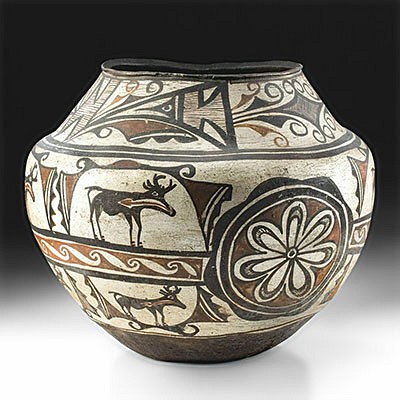Colima Coahuayana Valley Redware Seated Male Figure
Lot 52
About Seller
Artemis Fine Arts
686 S Taylor Ave, Ste 106
Louisville, CO 80027
United States
Selling antiquities, ancient and ethnographic art online since 1993, Artemis Gallery specializes in Classical Antiquities (Egyptian, Greek, Roman, Near Eastern), Asian, Pre-Columbian, African / Tribal / Oceanographic art. Our extensive inventory includes pottery, stone, metal, wood, glass and textil...Read more
Categories
Estimate:
$6,500 - $9,750
Absentee vs Live bid
Two ways to bid:
- Leave a max absentee bid and the platform will bid on your behalf up to your maximum bid during the live auction.
- Bid live during the auction and your bids will be submitted real-time to the auctioneer.
Bid Increments
| Price | Bid Increment |
|---|---|
| $0 | $25 |
| $300 | $50 |
| $1,000 | $100 |
| $2,000 | $250 |
| $5,000 | $500 |
| $10,000 | $1,000 |
| $20,000 | $2,500 |
| $50,000 | $5,000 |
| $100,000 | $10,000 |
| $200,000 | $20,000 |
About Auction
By Artemis Fine Arts
Nov 18, 2021
Set Reminder
2021-11-18 10:00:00
2021-11-18 10:00:00
America/New_York
Bidsquare
Bidsquare : Art & Artifacts of North America
https://www.bidsquare.com/auctions/artemis-gallery/art-artifacts-of-north-america-7894
Join us for a special auction not to be missed! Collectible Native American art from antiquity to mid-20th century, Spanish Colonial, Latin American, Pre-Columbian, fine & folk art, American frontier items, fossils, and much more! Artemis Fine Arts info@artemisgallery.com
Join us for a special auction not to be missed! Collectible Native American art from antiquity to mid-20th century, Spanish Colonial, Latin American, Pre-Columbian, fine & folk art, American frontier items, fossils, and much more! Artemis Fine Arts info@artemisgallery.com
- Lot Description
Pre-Columbian, West Mexico, Colima, Coahuayana Valley type, Protoclassic Period, ca. 100 BCE to 250 CE. A hollow-built redware pottery vessel of a rare form from the Coahuayana Valley depicting a portly man seated upon an integral quadruped stool. The highly burnished figure features deep red and orange hues and presents nude with splayed toes in front of broad feet, delineated legs with bent arms resting atop rounded knees, and a slightly distended abdomen beneath broad shoulders adorned with ritual scarification nodules. The stylized countenance showcases coffee-bean-shaped eyes flanking a prominent nose, gently impressed and raised eyebrows, pierced ears, and a plateaued brow surmounted by the flared vessel rim. Size: 9.5" W x 15.375" H (24.1 cm x 39.1 cm)
Clay figures like this one are the only remains that we have today of a sophisticated and unique culture in West Mexico - they made no above-ground monuments or sculptures, at least that we know of, which is in strong contrast to developments elsewhere in ancient Mesoamerica. Instead, their tombs were their lasting works of art: skeletons arrayed radially with their feet positioned inward, and clay offerings, like this one, placed alongside the walls facing inward, near the skulls. A large effigy like this one most likely would have flanked the entrance to a tomb in a way that archaeologists have interpreted as guarding. Some scholars have interpreted these dynamic sculptures of the living as a strong contrast to the skeletal remains whose space they shared, as if they mediated between the living and the dead.
Cf. Kan, Michael, Clement Meighan, and H.B. Nicholson. "Sculpture of Ancient West Mexico: Nayarit, Jalisco, Colima | A Catalogue of the Proctor Stafford Collection at the Los Angeles County Museum of Art." University of New Mexico Press, Albuquerque, 1989, p. 137, fig. 122 and p. 139, fig. 127.
Provenance: private New York, USA collection, acquired around 1966, ex-Land's Beyond, NY
All items legal to buy/sell under U.S. Statute covering cultural patrimony Code 2600, CHAPTER 14, and are guaranteed to be as described or your money back.
A Certificate of Authenticity will accompany all winning bids.
PLEASE NOTE: Due to recent increases of shipments being seized by Australian & German customs (even for items with pre-UNESCO provenance), we will no longer ship most antiquities and ancient Chinese art to Australia & Germany. For categories of items that are acceptable to ship to Australia or Germany, please contact us directly or work with your local customs brokerage firm.
Display stands not described as included/custom in the item description are for photography purposes only and will not be included with the item upon shipping.
#159189Repairs to left leg below knee and back-right stool leg, with very small chips and light adhesive residue along break lines. Minor abrasions to stool, limbs, body, and head, with fading and small areas of fire-darkening to pigment, and light encrustations within some recessed areas. Great remains of pigment throughout and manganese deposits along upper body.Condition
- Shipping Info
-
All shipping is handled in-house for your convenience. Your invoice from Artemis Gallery will include shipping calculation instructions. If in doubt, please inquire BEFORE bidding for estimated shipping costs for individual items.
-
- Buyer's Premium



 EUR
EUR CAD
CAD AUD
AUD GBP
GBP MXN
MXN HKD
HKD CNY
CNY MYR
MYR SEK
SEK SGD
SGD CHF
CHF THB
THB
















